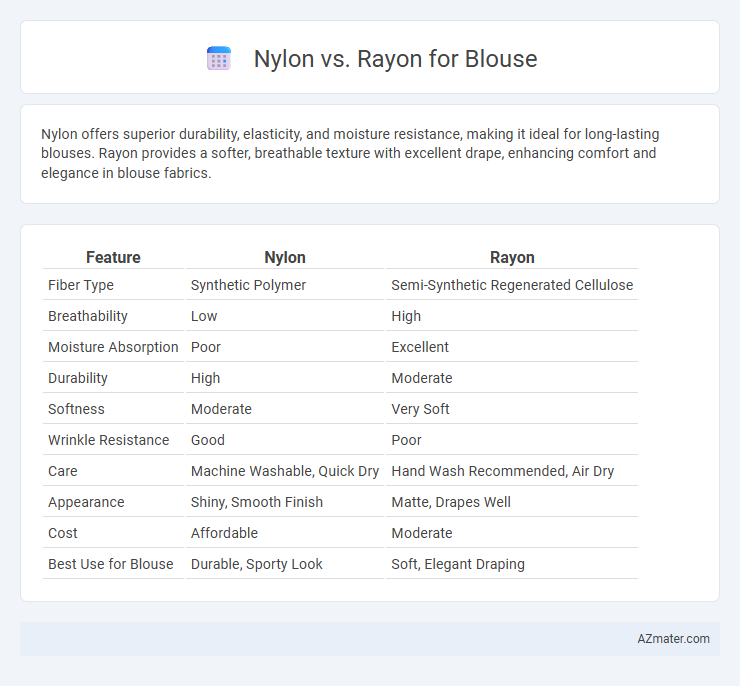Nylon offers superior durability, elasticity, and moisture resistance, making it ideal for long-lasting blouses. Rayon provides a softer, breathable texture with excellent drape, enhancing comfort and elegance in blouse fabrics.
Table of Comparison
| Feature | Nylon | Rayon |
|---|---|---|
| Fiber Type | Synthetic Polymer | Semi-Synthetic Regenerated Cellulose |
| Breathability | Low | High |
| Moisture Absorption | Poor | Excellent |
| Durability | High | Moderate |
| Softness | Moderate | Very Soft |
| Wrinkle Resistance | Good | Poor |
| Care | Machine Washable, Quick Dry | Hand Wash Recommended, Air Dry |
| Appearance | Shiny, Smooth Finish | Matte, Drapes Well |
| Cost | Affordable | Moderate |
| Best Use for Blouse | Durable, Sporty Look | Soft, Elegant Draping |
Introduction: Nylon vs Rayon for Blouses
Nylon and rayon are two popular fabrics used in blouse manufacturing, each offering unique properties ideal for different style and comfort preferences. Nylon, a synthetic fiber, is valued for its durability, wrinkle resistance, and moisture-wicking abilities, making it suitable for active wear and long-lasting garments. Rayon, derived from natural cellulose, provides a soft, breathable texture with excellent drape and vibrant color retention, enhancing the blouse's aesthetic appeal and comfort.
Fabric Origins and Composition
Nylon, a synthetic fabric derived from petrochemicals, offers high strength, elasticity, and durability, making it resistant to wear and moisture. Rayon, a semi-synthetic fiber produced from regenerated cellulose derived from wood pulp, mimics natural fibers with its softness, breathability, and drape. The distinct origins and molecular compositions of nylon and rayon influence their comfort, moisture management, and care requirements in blouse fabrics.
Texture and Feel Against the Skin
Nylon offers a smooth, sleek texture that feels soft and lightweight against the skin, making it ideal for blouses that require a silky finish and durability. Rayon provides a natural, breathable feel with a slightly more absorbent and cooler touch, enhancing comfort in warm weather while maintaining a smooth surface. Both fabrics offer distinct tactile experiences, with nylon favoring resilience and shine, and rayon emphasizing softness and breathability.
Breathability and Comfort
Nylon offers durability and moisture-wicking properties but lacks breathability compared to rayon, which is highly breathable and soft, making it ideal for blouses worn in warm climates. Rayon mimics natural fibers with excellent ventilation, promoting comfort by reducing sweat accumulation, while nylon can trap heat, potentially causing discomfort in hot weather. Choosing rayon enhances airflow and keeps the skin cool, whereas nylon is better suited for structured blouses requiring stretch and resilience.
Durability and Longevity
Nylon blouses offer superior durability due to their high tensile strength and resistance to abrasion, making them ideal for long-term wear. Rayon, while soft and breathable, tends to weaken faster with repeated washing and exposure to moisture, reducing its longevity. Choosing nylon ensures a blouse maintains its shape and appearance over extended use, outperforming rayon in durability and lifespan.
Moisture Management and Quick Drying
Nylon excels in moisture management with high water resistance and quick-drying properties, making it ideal for blouses requiring durability and fast evaporation. Rayon absorbs moisture more readily but dries slower due to its natural cellulose fibers, offering breathability but less efficient moisture control. For active wear or humid conditions, nylon blouses provide superior performance in keeping skin dry and comfortable.
Color Retention and Fading Resistance
Nylon exhibits superior color retention and fading resistance compared to rayon, making it an ideal choice for blouses exposed to frequent washing and sunlight. Its synthetic polymer structure allows vibrant colors to remain intact over time, while rayon, being semi-synthetic, tends to fade more quickly due to lower fiber durability and higher absorbency. Choosing nylon enhances blouse longevity by maintaining color intensity even after multiple washes and prolonged wear.
Maintenance and Care Tips
Nylon blouses require gentle machine washing with cold water and low heat drying to maintain fabric integrity and prevent shrinking, while rayon blouses necessitate hand washing or dry cleaning to avoid damage and preserve softness. Both fabrics benefit from avoiding bleach and ironing at low temperatures to prevent fiber deterioration. Proper storage in cool, dry places extends the lifespan of nylon and rayon blouses by minimizing exposure to moisture and sunlight.
Price Comparison and Affordability
Nylon blouses tend to be more affordable than rayon ones due to nylon's synthetic manufacturing process, which lowers production costs. Rayon, being a semi-synthetic fiber derived from natural cellulose, generally involves more expensive processing techniques, resulting in higher retail prices. Consumers seeking budget-friendly blouse options often find nylon garments provide better value without sacrificing style or durability.
Best Uses: Choosing the Right Fabric for Your Blouse
Nylon offers durability and wrinkle resistance, making it ideal for blouses that require long-lasting wear and easy maintenance. Rayon provides excellent breathability and a silky texture, perfect for lightweight, flowy blouses suited to warm weather. Selecting nylon suits active or structured styles, while rayon complements elegant, draped designs for comfort and style.

Infographic: Nylon vs Rayon for Blouse
 azmater.com
azmater.com